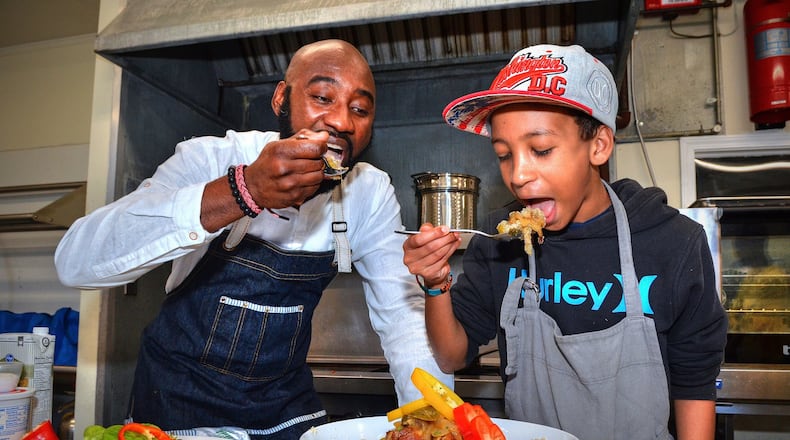The people of Senegal are famous for their generosity. The Wolof word (Wolof is the language most widely spoken in Senegal) is “teranga,” meaning “hospitality,” and teranga is most often expressed by sharing food.
Dakar-born chef Cheikh Ndiaye named his Atlanta-based catering business Teranga Without Borders. Preparing the dishes of Senegal for clients and friends is how he shares the food of his childhood with the larger world.
Twelve-year-old Fallou Diouf has never been to Senegal although that’s his father’s homeland. Fallou joined Ndiaye on a January Sunday afternoon to learn to make chicken yassa, ndambe and other dishes of his Senegalese roots. They met in the kitchen of Project Community Connections Inc., a nonprofit that works to rehouse the homeless. Ndiaye hopes to employ some of their clients as his business grows.
Fallou’s mother, Danielle Carter, spent four years working for a nonprofit and traveling back and forth from Atlanta to Senegal. The only Senegalese dish she now makes at home is mafe, a stew that includes lots of vegetables cooked in a creamy, spicy tomato and peanut sauce.
“I just never feel like what I made at home tastes like what I remember, so I’m glad Fallou has the chance to learn these recipes,” she said.
The food of Senegal, like that of much of West Africa, relies heavily on rice, Maggi liquid seasoning and bouillon cubes along with onions, garlic and fresh tomatoes. Because Ndiaye prefers to make healthier versions of traditional dishes, he substitutes smaller quantities of Worcestershire or soy sauces for the highly salty Maggi flavorings and prefers small whole grains like millet and fonio (both widely eaten in Senegal) to rice.
Joining them was Mouhamed Ndiaye (no relation to Cheikh, who says “Ndiaye” is as common a name in Senegal as “Smith” or “Jones”), a chef and friend of Cheikh’s, who brought the equipment for “attaya,” the tea ceremony that is part of every Senegalese day. Attaya is a ceremony of three rounds of green tea, brewed with fresh mint and sugar. Each round is poured from a tea kettle held high with the tea cascading into small glasses. “The first round is bitter, the second sweeter and the third is sweetest. It can take hours and the teapot is kept boiling with more water added as the day goes on,” said Mouhamed.
Cooking done, the chefs and Fallou sampled the dishes they’d prepared, and Cheikh explained the principle of “eating around the bowl.”
Meals in Senegal are often served in one large communal bowl. Eating around the bowl is considered a sign of trust, and there’s an etiquette to be observed. “You eat only from the part of the bowl that is in front of you. If you are an honored guest, you might find your host will pick the best parts of the dish and place them in front of you. And when you’re finished eating, you leave the bowl to make room for others who might want to eat,” said Cheikh.
And then around bowls of thiakry, Cheikh taught his guests the Wolof equivalent of “Bon appétit.”
“Na Rees Ak Diamm,” he wished all. “Digest peacefully.”
RECIPES
You’re likely to find the food of Senegal is a delicious combination of the familiar and the exotic.
Ndambe
Ndambe is ubiquitous in Senegal, sold in every village and on the streets of Dakar as a snack or a light dinner. It’s traditionally served as the filling of a baguette, a nod to Senegal’s French colonial roots, and although considered the food of the poor, is beloved by all. Chef Cheikh Ndiaye says most often the peas are cooked to mush. He lightened up the dish by not cooking the peas so long and by serving the ndambe in lettuce wraps rather than on bread.
One cup (about 6 ounces) of dried peas will yield 2 cups of soaked peas. No yucca? Just double up on the sweet potato.
And a note: A Senegalese cook would never discard the bay leaves. If you’re lucky enough to get them in your portion, you’ll suck all the goodness off the leaves before discarding them.
— Adapted from a recipe provided by Cheikh Ndiaye of Teranga Without Borders.
Chicken Yassa
Chicken Yassa is considered one of the national dishes of Senegal. The chicken is grilled or roasted, then cooked in a rich onion and olive sauce until it falls off the bone. Served atop a big dish of jasmine rice, it’s traditionally eaten with the fingers, each diner dipping only into the portion directly in front of him or her. Ndiaye garnishes his finished dish with slices of bell pepper in green, yellow and red, mimicking the colors of the flag of Senegal.
— Adapted from a recipe provided by Cheikh Ndiaye of Teranga Without Borders.
Fonio
Fonio is another ancient grain that is getting more attention these days. It is a tiny, tiny form of millet that’s been cultivated in West Africa for thousands of years. Chicken Yassa is traditionally served with jasmine rice, but Ndiaye suggests serving it with fonio for a healthier version.
— Adapted from a recipe provided by Cheikh Ndiaye of Teranga Without Borders.
Thiakry
In Senegal, thiakry is often sold by street vendors, but it’s also a dish that’s made at home. This very traditional Senegalese dessert is like rice pudding but tangy from the use of sour cream. We tried making it with couscous and bulgur (just soaked instead of cooked) as well as millet and liked those versions as well. Millet is widely eaten in Senegal and is a vital crop in that country. One reason is that it’s drought-resistant and survives on less than fertile soil. It’s also high in calcium, iron and protein.
— Adapted from a recipe provided by Cheikh Ndiaye of Teranga Without Borders.
Bissap
This beverage made from hibiscus (also called roselle and sorrel) blossoms is consumed from the Caribbean to South America to Africa and Asia. Ndiaye says it’s considered the national drink of Senegal.
— Adapted from a recipe provided by Cheikh Ndiaye of Teranga Without Borders.
Per cup: trace calories (percent of calories from fat, 0), trace protein, trace carbohydrates, trace fiber, no fat, no cholesterol, 8 milligrams sodium.
Read more stories like this by liking Atlanta Restaurant Scene on Facebook, following @ATLDiningNews on Twitter and @ajcdining on Instagram.
About the Author
Keep Reading
The Latest
Featured








